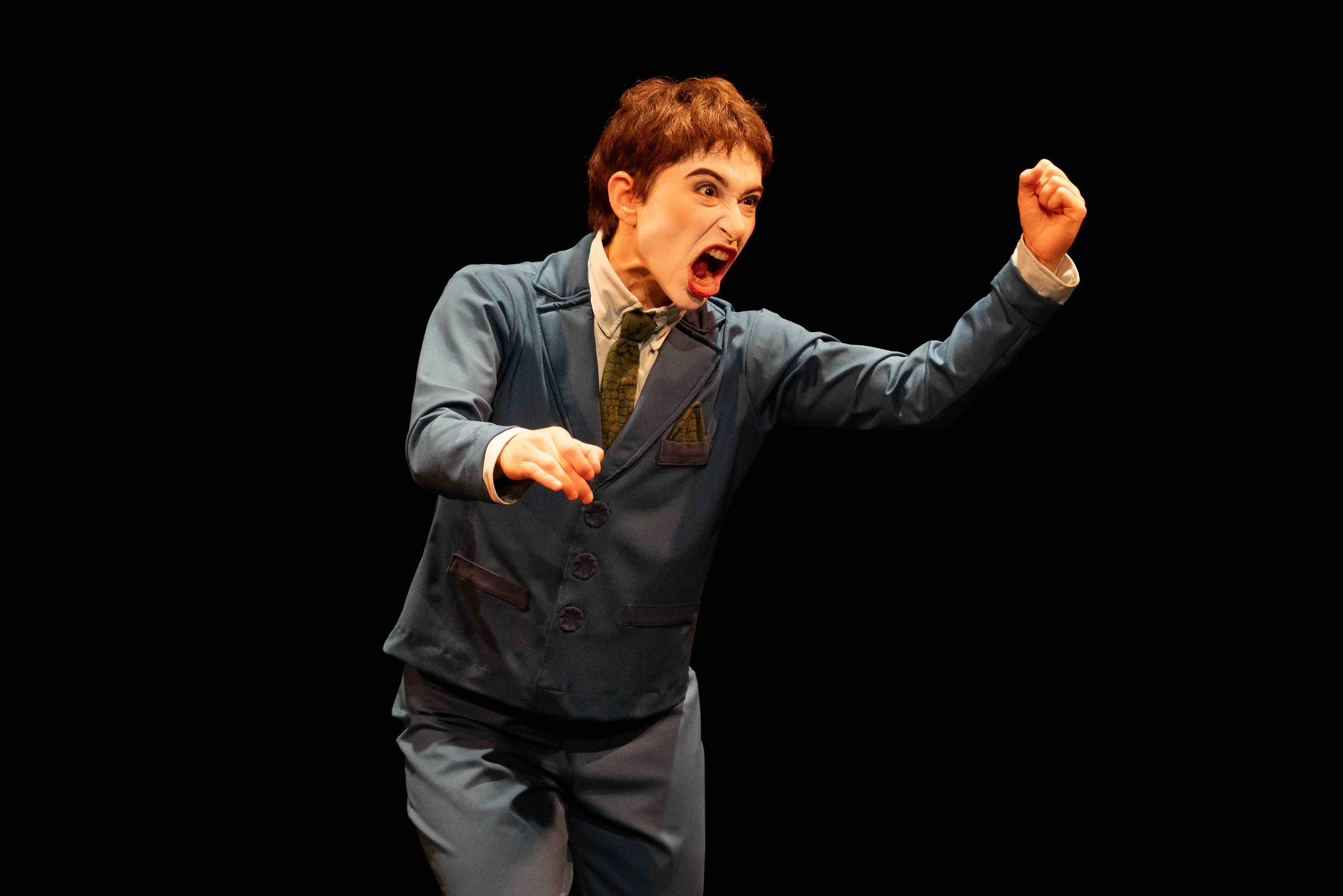Theatre review: Studio 58 cast brings heart to polished A Chorus Line production
Some singular sensations amid rising triple-threat talents, in a rendition that builds to a blowout finale
(Left to right) Brian Martinez, Brodie Kyle Klassen, Hikari Terasawa, L Danger, and Janavi Chawla. Photo by Emily Cooper
Studio 58 presents A Chorus Line to February 19
A CHORUS LINE is one of the most iconic Broadway musicals of all time, and for performers it’s a very personal show, because it depicts the lives of dancers with frightening accuracy.
Studio 58, the professional theatre-training program at Langara College, has captured the spirit of the celebrations, challenges, heartache, and love that dancers experience universally, in a production that’s creative, polished, and handles personal storylines with great sensitivity and respect.
A Chorus Line is set at a Broadway musical audition on a bare stage in the 1970s. We see director Zach lead the auditionees through a dance audition, “I Hope I Get It”. Afterward, Zach makes a cut and we’re left with 17 performers who will compete for the eight dancer spots. For the remainder of the show, we learn about each one of them, as Zach tries to get to know every performer’s backstory and true self before making his decisions.
We hear stories from childhood, through adolescence, and into adulthood, that everyone—not only dancers—can relate to. There’s a balance of lighter and heavy subject matter. For example, some of the fun moments include a section (which many male dancers can relate to) when Mike performs “I Can Do That” to tell how he first got into dance by following in his sister’s footsteps.
“Sing” is a cute number performed by married couple Kristine and Al, where Kristine laments her inability to sing. “Dance: Ten; Looks: Three” is a hilarious, cheeky number where we hear how Val took matters into her own hands when she wasn’t getting hired because of her physical appearance. And the series of “Hello Twelve” montages takes everyone back to their middle school days (get ready for some flashbacks to your own awkward teenage days).
As for the heavy subject matter: we hear about fighting parents, getting bullied, homophobia, sexual assault, the weight of expectations, and more. This is a show that approaches issues with honesty, as painful as it may be.
Thankfully, the acting in this production is exceptional. This isn’t a surprise, as Studio 58 is renowned for its acting program, and this rendition is a great showcase for it.
For one thing, the dialogue in the show is very 1970s, which is difficult to pull off without sounding awkwardly dated. But the young performers deliver it naturally, nailing the inflections and style of speech. Additionally, we really get to know characters through not just the dialogue but the in-between moments, such as pauses and gestures, as opposed to just the big vocal solos. Emma Soothill is sensational as the sassy and confident Sheila. Even before she says anything, she already oozes attitude. Soothill is captivating to watch, and every word she speaks, every step, and every hand gesture is completely character-driven.
The stage is a wonderful collection of personalities. You can feel Diana’s (Janavi Chawla) anxiety when Zach calls upon her early in the show to talk about herself. As Maggie, Hailey Conner has a warm energy that radiates through the entire theatre. Ivy Charles illuminates the room with her lively, entertaining portrayal of energetic Richie. Brian Martinez is outstanding as Paul, who has a very dark storyline and difficult monologue to pull off; he delivers it with genuineness and great pacing, and director Courtenay Dobbie has approached this section with notable sensitivity.
As a famed dancer who’s now competing for a role back in the chorus, L Danger also performs with excellent genuineness. Most notably, in her dialogue with Zach during “One”, she speaks with sincerity when arguing that every dancer onstage is a special, unique individual. Extremely poised in not only her character delivery but also her movement and stage presence, Danger makes for a great Cassie. And Sebastian Ley does a strong job of holding the show together as Zach, offering compassion when needed, and assertive direction at other times.
The singing and dancing, on the other hand, is coming along, with every student progressing at their own rate. And there a few standouts whom the musical theatre stage will surely be calling for after graduation. Ben Brown has a sensational singing voice, and he’s a strong actor as well, portraying Al with charm and humour. Hikari Terasawa is a stunningly beautiful dancer who is highly trained technically and has a lovely presence. Watching her dance in “At the Ballet” is a highlight. As Mike, Terrence Zhou delivers “I Can Do That” with great tap dancing and athleticism. And as Bobby, Samuel Walmsley-Byrne has wonderful energy and enthusiasm in his dancing, achieving nice elevation in his leaps.
One of the few criticisms I have of this production is the choice of footwear, which breaks the look of authenticity. For some strange reason, Cassie wears open-toe heels that look more appropriate for a night out on the town than a Broadway dance audition, where beige character shoes are the standard. It’s also a wonder that Danger is able to perform all her choreography in these shoes. Another odd example is Paul auditioning in bare feet, which would not have been the case in the 1970s.
The creative team—director Dobbie, choreographer Shelley Stewart Hunt, and musical director Diane Speirs—has done an excellent job of letting each student participate and shine in their own way. Vocal and dance solos usually performed by one character have been divided up to give everyone more performing opportunities, including the dancers who are “cut” after the opening number. Traditionally, these dancers sit backstage for the remainder of the show until the final number, but here, they come back onstage throughout, often filling in backstories of the onstage dancers.
Hunt has added her usual creativity and polish to all the dance numbers. “I Can Do That” is now a flashback of the dance class that Mike followed his sister to. “Nothing” is a comical re-enactment of Diana’s ill-fated acting class. There’s great use of incorporating the mirrors in “The Music and the Mirror”. And I loved the individuality of the end poses of “One”—a nod to the show’s message of uniqueness and individualism in all dancers.
And the show’s final number, a grand reprise of “One”, is simply thrilling. The cast does such a great job of bringing their characters to life throughout the show, that it’s a joy to celebrate them all at the end. Dressed up in glittery gold costumes and performing Hunt’s fabulous choreography, the students sparkle with Broadway pizazz. The audience is left cheering and longing for more after it’s all over. Studio 58’s production of A Chorus Line celebrates the one singular sensation that every performer is, and does so with an inclusive, sincere spirit.













